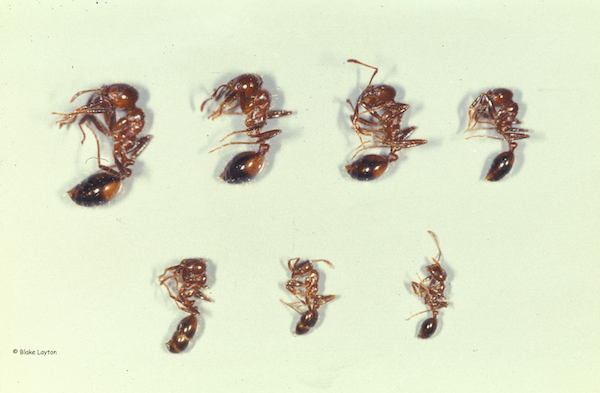Imported Fire Ant Workers, Vol. 7, No. 5
Related News
October 1, 2013
September 10, 2013
June 24, 2013
June 20, 2013

You may have noticed fire ants are not all the same size. Within a given mound there are big ants, little ants and middle-sized ants. In technical terms, these are called major workers, minor workers, and medias. There’s even a fourth, smaller size, called minims, but these only develop from the first eggs of a young queen trying to start a new colony.
All the ants in this photo are fully mature adult fire ants. The little ones are not “baby fire ants.” They are as big as they are ever going to get because insects do not continue to grow after they become adults. They can’t grow anymore because that external skeleton they have is like a suit of armor; it won’t stretch, and they are not going to get another one. (Ok, there are membranes between the plates of armor, which known as sclerites, that can stretch, especially in the abdomen, and this can allow some insects, like termite queens, to grow considerably after they become adults. But these are special cases, and usually it is only the abdomen that increases in size, because the sclerites of the head and thorax are fused together.)
Not all species of ants have different-sized workers. Many, such as Argentine ants, odorous house ants and tawny crazy ants, have workers that are all the same size. These are said to be “monomorphic.” Other species, such as black carpenter ants and fire ants are “polymorphic.” Major fire ant workers are about three times longer than minor workers and many-fold heavier. They also live considerably longer than minor workers, but a colony does not begin to produce major workers until it is around 6 months old.
One of the advantages of having different sized workers within the colony is that different-sized workers are better suited for different tasks. Minor workers are better for caring for brood, while major workers are better for colony defense and for heavy lifting tasks, such as tunneling and carrying food back to the colony. But there is considerable overlap here, with age being a key factor in determining what tasks a particular worker may do. Younger workers tend to stay inside and care for brood, while older workers spend more time foraging for food. There is also a difference in the sting. Major workers have longer stings and more venom, which makes them better suited for defending the colony against large vertebrates—like us. But the minor workers can sting too, and all the workers in a fire ant mound are females, so they all have stings.
Control: For information on different ways to control fire ants, see Bug's Eye View No. 12, Volume 6 and Extension Publication 2429, Control Fire Ants in Your Yard.
For more nerdy details on fire ant biology, as well as practical information on how to control fire ants in different situations, check out the MSU Extension Fire Ant Website.
Blake Layton, Extension Entomology Specialist, Mississippi State University Extension Service.
The information given here is for educational purposes only. Always read and follow current label directions. Specific commercial products are mentioned as examples only and reference to specific products or trade names is made with the understanding that no discrimination is intended to other products that may also be suitable and appropriately labeled.
Mississippi State University is an equal opportunity institution.
Bug’s Eye View is now on Facebook. Join the Bug's Eye View Facebook group here.